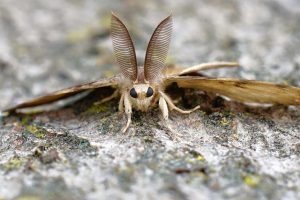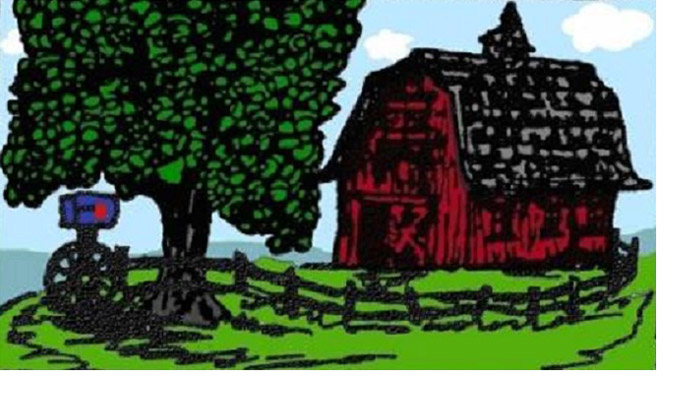
And it is — because as a caterpillar, it ravages leaves. What’s being done in Illinois.
Say hello to a male spongy moth, aka Lymantria dispar, with its remarkable bat-like antennae. Getty Images
As a caterpillar, the invasive spongy moth consumes as much leaf tissue as it can, as fast as it can, threatening the lives of whole forests across the upper Midwest.
But Illinois continues to stand on the front lines when it comes to slowing the westward spread of this insect with a voracious appetite.
To protect our trees and contain the insect’s migration, county forest preserve districts are working with the Illinois Department of Agriculture to treat various natural areas in the greater Chicago region, including in Aurora, Lemont and Naperville.
Historically known as the “gypsy moth,” spongy moth caterpillars have a feeding period that lasts seven to 10 weeks through the spring and summer. A single spongy moth caterpillar can eat 11 square feet of vegetation during its lifetime, and its host plants include more than 300 tree and shrub species.
With the ability to completely strip trees bare year after year, spongy moths have the potential to severely affect trees and forests. But since an Illinois county was quarantined first — Lake County in 2000 — two types of prevention treatments have proved successful at holding the line, or least slowing it down.
The yearly treatments involve low-flying helicopters or yellow agricultural planes that release either a pesticide or a mating disruption agent.
Spraying of the insecticide, known as BTK or Bacillus thuringiensis kurstaki, took place last month in areas in Aurora, Galena, Lemont and West Chicago. BTK solely affects caterpillars and is not toxic to people, animals or other insects. The insecticide has been used in the greater Chicago area since 1980.
While that means BTK kills all caterpillars and not just spongy moths, studies show the agent does not have long-lasting effects on native species, said Scott Schirmer, a plant regulatory official with the Illinois Department of Agriculture.
“We’re basically dumping a bucket of water on the spongy moth campfire. That area is going to be eliminated of spongy moths, but there’s going to be all the natives in the surrounding area that can basically backfill into that hole relatively quickly,” Shirmer said. “Studies show that the natives will repopulate or recolonize an area that’s been treated with BTK in a matter of a couple of years.”
Schirmer added the treatment has even less of an impact on butterflies, like the monarch, which depend on prairie plants such as milkweed rather than forest trees.
The mating disruption treatment, which consists of a pheromone meant to confuse and overwhelm male spongy moths, will be sprayed by the yellow “air tractor” planes later this month in 12 different areas, including St. Charles, Geneva and Naperville.
A map of this year’s treatment plan can be found at tinyurl.com/IllinoisSpongyMothMap.
To identify which areas to target, the state Department of Agriculture tracks for spongy moth hot spots in two ways: pheromone traps and egg mass surveys. The department’s efforts are at times supplemented with monitoring by forest preserve districts.
The DuPage County Forest Preserve District, for instance, will often survey for spongy moths and send its data to the state. While the district used to conduct its own treatments in addition to the state’s protocol, ecology supervisor Tom Velat said the front line of spongy moth migration has moved further west.
“There’s limited resources, so they’re concentrating on the areas that’re going to have the most impact on trees,” Velat said. “If they can suppress that impact in those first few years, as the populations of natural predators start to build up their numbers, then you start to see a little bit more of a balance come into play where the moths can be reduced to a point where they don’t cause massive die-off of trees.”
Treatments are led and executed by the Illinois Department of Agriculture in collaboration with a national program called Slow the Spread, which the state joined in 2006.
The program has three objectives: suppress high populations in quarantined areas, limit the rate of migration from infested to non-infested areas, and eliminate isolated populations that arise beyond the advancing front.
Though these methods have been successful in reducing the moth’s rate of spread from a natural pace of 30 miles a year to three miles a year, there’s no hope for total eradication.
“This is something that we’ve effectively lived with for the past century-plus, and will probably continue to live with,” Schirmer said. “What we’re doing in Illinois is offering protection to Iowa, Missouri, Arkansas — those western states and south and southwestern states. Ultimately, it’s going to get there one way or another. What we’re trying to do is prevent those large jumps and buy people time to either prepare for it or get their management plan in place.”
Native to Eurasia, the spongy moth was brought intentionally to the U.S. in 1869 by an amateur entomologist. Caterpillars escaped from the entomologist’s home in Medford, Massachusetts, and spread throughout northeastern America. The line of invasion is now a band that spans from North Carolina to Minnesota.
The winged bug underwent a name change along with the “gypsy ant” in 2021 as part of a larger movement in the scientific community to reconsider potentially problematic naming.
The change was led by the Entomological Society of America’s Better Common Names Project.
Technically referred to as the Lymantria dispar, the spongy moth’s new name refers to the insect’s unique spongy-textured egg masses. The eggs are a key identifier in slowing the moth’s migration, as they can be moved inadvertently on outdoor items like firewood, lawn equipment and campers.
If you live in or travel to a quarantined county — Lake, McHenry, Cook, DuPage, Kane, Kendall, Will, Lasalle, Winnebago and Boone — officials encourage you to refrain from transporting firewood, and to inspect all outdoor gear and vehicles for egg masses.
“Don’t hesitate to call,” Schirmer said. “If anybody sees something that doesn’t look right, that they’ve never seen before, or if, all of a sudden, their trees go from looking great one year to bad the next, give us a call, give extension a call or give your municipal public works department a call.”
The Department of Agriculture’s northern Illinois field office can be reached at (815) 347-0401.
More information on the Slow the Spread program, including nationwide treatment maps and spongy moth history, can be found at slowthespread.org
